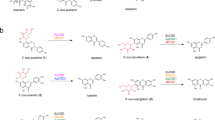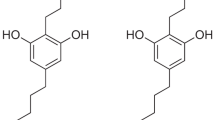Abstract
IT has been shown recently by Brown and his co-workers1 that when digitoxin was administered to rats or to adult humans some of it underwent hydroxylation at C12 to give digoxin. This fact, suggestive of the possibility of such bioconversions to be effected by micro-organisms as well, prompted us to investigate microbiological transformation of the cardiac glycosides and their aglycones. In this communication we wish to report that the C12- and C16- hydroxylations of digitoxigenin.
This is a preview of subscription content, access via your institution
Access options
Subscribe to this journal
Receive 51 print issues and online access
$199.00 per year
only $3.90 per issue
Buy this article
- Purchase on Springer Link
- Instant access to full article PDF
Prices may be subject to local taxes which are calculated during checkout
Similar content being viewed by others
References
Brown, B. T., Wright, S. E., and Okita, G. T., Nature, 180, 607 (1957). Later, K., Repke also obtained the same results, Naturwiss., 45, 94, 366 (1958).
Sasakawa, Y., Yakugaku Zasshi, 75, 946 (1955).
Jensen, K. B., and Tennöe, K., J. Pharm. Pharmacol., 7, 334 (1955).
Tschesche, R., Grimmer, G., and Seehofer, F., Chem. Ber., 86, 1235 (1953).
Gubler, A., and Tamm, C., Helv. Chim. Acta, 41, 297, 1762 (1958).
Author information
Authors and Affiliations
Rights and permissions
About this article
Cite this article
NAWA, H., UCHIBAYASHI, M., KAMIYA, T. et al. Microbiological Transformation of a Cardiac Aglycone. Nature 184, 469–470 (1959). https://doi.org/10.1038/184469a0
Issue Date:
DOI: https://doi.org/10.1038/184469a0
This article is cited by
-
Experimental results relating to the metabolism of the cardiac glycosides
Chemistry of Natural Compounds (1973)
Comments
By submitting a comment you agree to abide by our Terms and Community Guidelines. If you find something abusive or that does not comply with our terms or guidelines please flag it as inappropriate.



